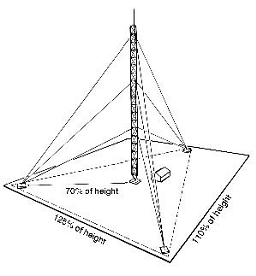Rural Interstate Corridor Communications Study
Report to States
Appendix A
3.0 Towers/Facilities
An important consideration of a telecommunications backbone design is the use and accessibility of the backbone infrastructure from points located away from the Interstate ROW. A comprehensive design would be a hybrid design of conduit infrastructure for fiber optic cabling along the ROW in addition to tower location and design for wireless components of the backbone. These towers would allow for wireless transmission outside the limits of the ROW. Including tower facilities as part of the design will enable middle and last mile options in the future.
Several factors are considered in determining the location of a tower (and support building), including:
- Line of Sight: Many wireless technologies require line of sight between the transceivers in order for signals to be exchanged from one location to another. All other wireless technologies are more effective if line of sight can be maintained.
- Topography/Geotechnical: In conjunction with line of sight, high topography can enhance the distance a wireless signal will travel. Valleys will limit the distance a wireless signal will travel. Additionally, a tower site must have soil that can support a tower.
- Ease of Construction/Maintenance: There must be ample room (width) in the ROW for construction staging and on-going maintenance parking. Ideal locations include interchanges and road crossings.
- Safety: The tower should be located far enough from the roadside that it will not cross the roadway should it fall.
- Proximity to existing power and communications infrastructure: The tower and supporting building require power and connection to the existing fiber optic backbone. The closer a tower site is located to existing power and fiber optic access points, the less expensive it will be to construct and operate the tower and its support facilities.
Towers can be self supporting or guyed. Self supporting towers are usually more expensive to construct and require less land. The taller the tower, the larger the concrete foundation needs to be to support the tower. Conversely, guyed towers are usually less expensive to construct and require more land. Towers are generally no more than 300' high.
Figure 3.1: Guyed Tower

Most tower manufacturers suggest a standard guy radius of 70 percent (80 percent for microwave) of the overall tower height. The table below shows approximate land areas needed for several tower heights.
Table 3.1: Minimum Land Area Required for Guyed Towers
Not Applicable |
Area Required |
Area Required |
Tower Height (feet) |
80% Guyed (feet x feet) |
70% Guyed (feet x feet) |
60 |
87 x 100 |
78 x 90 |
80 |
111 x 128 |
99 x 114 |
100 |
135 x 156 |
120 x 140 |
120 |
159 x 184 |
141 x 164 |
140 |
183 x 212 |
162 x 188 |
160 |
207 x 240 |
183 x 212 |
180 |
231 x 268 |
204 x 236 |
200 |
255 x 296 |
225 x 260 |
210 |
267 x 304 |
236 x 272 |
220 |
279 x 322 |
246 x 284 |
240 |
303 x 350 |
267 x 308 |
250 |
315 x 364 |
278 x 320 |
260 |
327 x 378 |
288 x 334 |
280 |
351 x 406 |
309 x 358 |
300 |
375 x 434 |
330 x 382 |
The best use of a tower includes co-location of multiple wireless services/technologies. With the exception of AM (amplitude modulated) radio stations, it should be assumed that all towers will host a variety of co-located wireless services/technologies. AM towers are actually the antenna that transmits the AM radio signals. Therefore, it is nearly impossible to co-locate other wireless services/technologies on an AM tower.
Tower spacing is based on the different types of wireless technologies used and can vary greatly among the different transmitting/receiving frequency bands. It is not possible to develop a typical tower spacing to cover all of the varieties of frequency bands.
- FAA Obstruction Evaluation
The Federal Aviation Administration (FAA) considers antenna towers an obstruction and therefore, their use of airspace must be studied. The FAA requires an analysis to be completed that identifies the public and private airports and heliports (focusing on the location of runways or landing pads), the proposed height of an antenna tower, and the intervening terrain. The FAA sets maximum antenna tower heights based on type (use) of airfield and slope between that airfield and the top of the antenna tower, and the distance to the antenna tower. An application must be filed with the FAA and should be filed a minimum of 60 days before construction is expected to begin. Some States also require an application to the state aviation division for approval of the height of the tower.